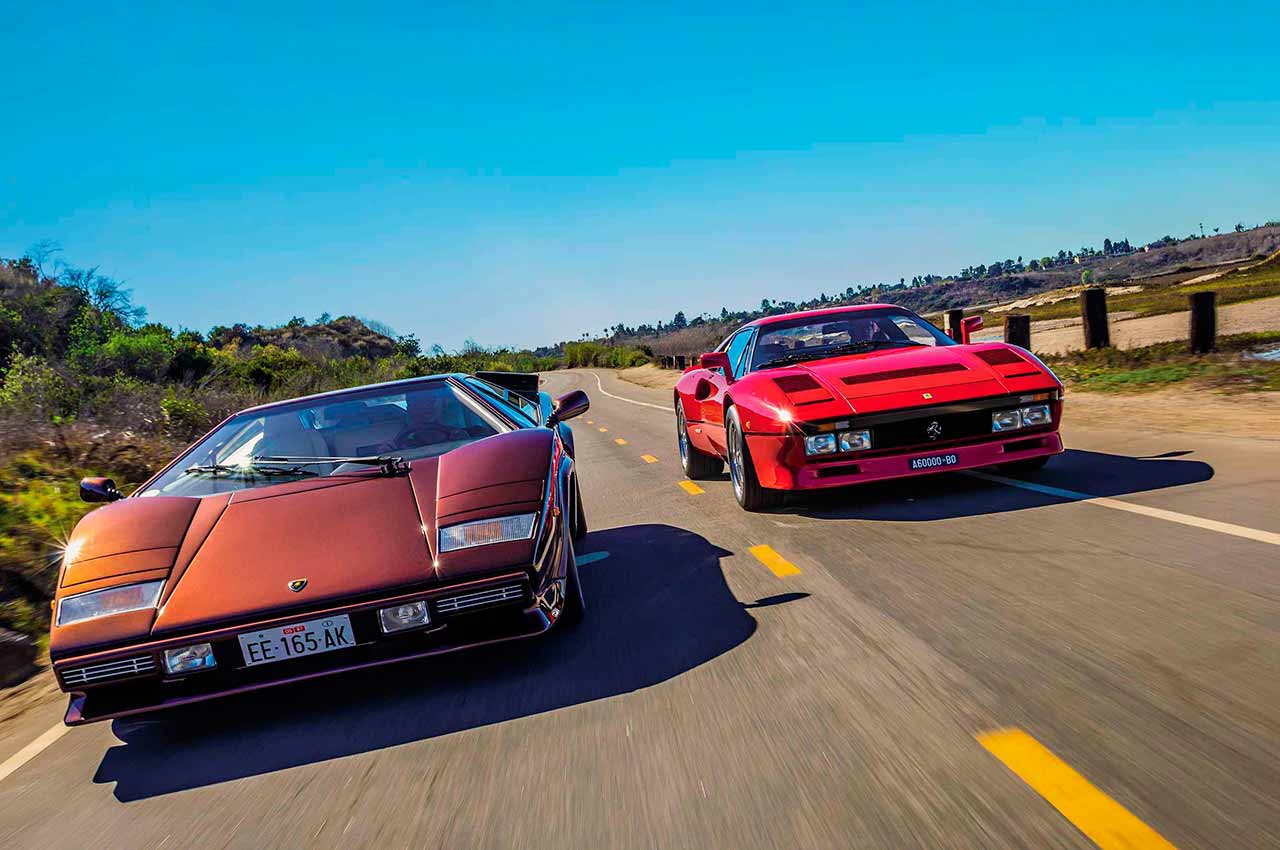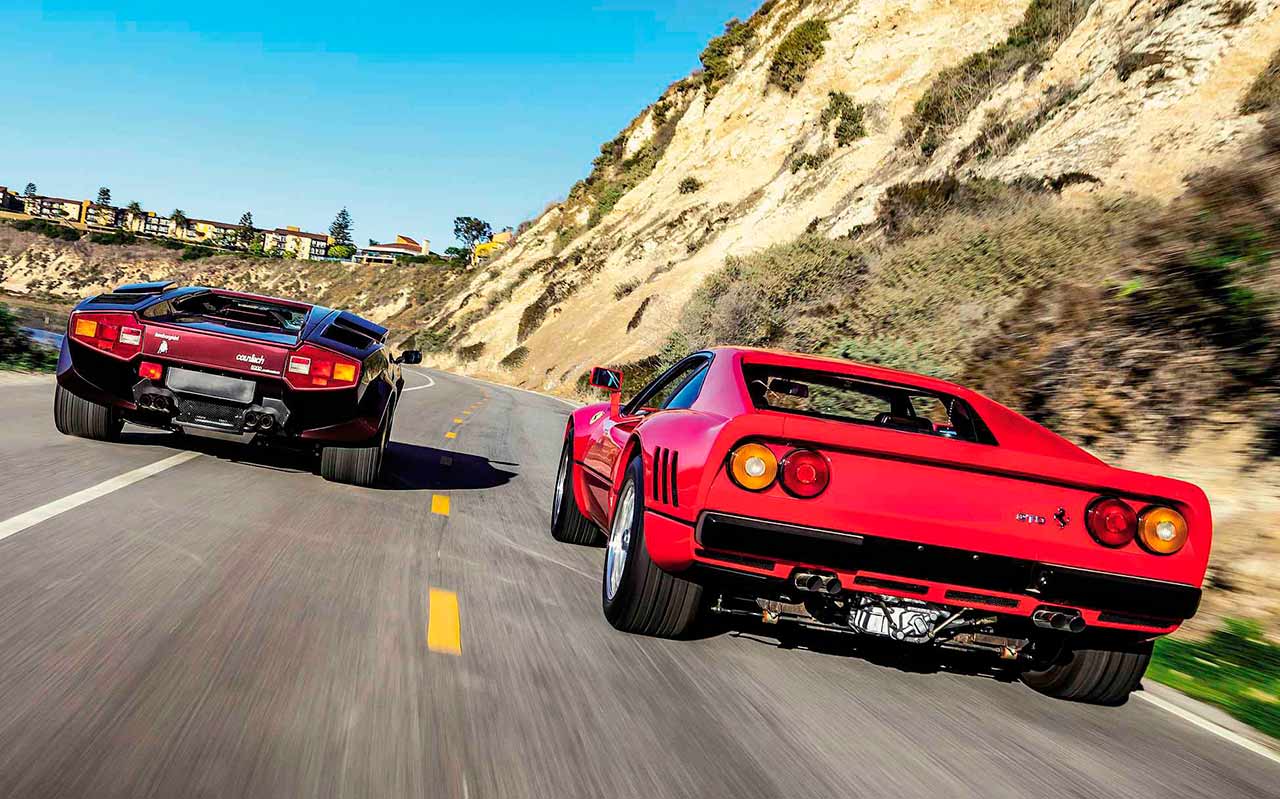
Countach vs GTO Pistons At Dawn. Lamborghini and Ferrari have been rivals forever, but the Countach Downdraft could have taken on the 288 GTO in a whole new way. Time for a showdown. Words John Thomas. Photography Evan Klein.
COUNTACH vs 288 GTO Lamborghini and Ferrari in the ’80s Group B battle that never happened… until now
Said James Bond, during 1974’s The Man with the Golden Gun: ‘Pistols at dawn – that’s a little old-fashioned, isn’t it?’ And Francisco Scaramanga answered: ‘That it is. But it remains the only true test for gentlemen.’

And sometimes the only thing to do is name a place and meet to settle the score. The reason for Lamborghini’s existence as a marque is steeped in rivalry with Ferrari, and that very relationship has become a cause célèbre among the faithful. In fact, some would argue that Lamborghini’s raison d’être was to outdo Ferrari in the roadgoing sports car game, and stories abound of early-morning impromptu duels between factory test drivers on the roads around Modena, inevitably with Dario Beluzzi driving the Ferrari and Valentino Balboni at the wheel of the Lamborghini.
The age-old Ferrari versus Lamborghini challenge seems like a perfect story. In this case, the place is California’s Newport Beach, the hour a pre-dawn 5am call, and the protagonists are a (rather special, unique) Lamborghini Countach and a Ferrari 288 GTO (not quite unique, still very special).
The Countach 5000QV is a 5.2-litre, 48-valve evolution of what was a 14-year-old design, sanctioned by none other than company owner Patrick Mimran. Had Mimran not rescued Lamborghini from the jaws of bankruptcy in 1980, there would have been no such car. It’s interesting that this example was his own personal one-off, painted in Bordeaux Speciale, with a blueprinted engine good for 470bhp (15bhp more than standard). It has been fully restored in California by its enthusiast owner.
The 288 GTO, meanwhile, was sanctioned by Enzo Ferrari as a car that might venture into Group B racing. Had The Old Man not agreed to revive those three hallowed initials and to allow his engineers to build a homologation special, there would have been no 288 GTO. Nor, for that matter, would there subsequently have been the F40. But that’s another story.

Naturally, the 288 GTO was FIA-homologated as soon as 200 examples of this 308 GTB-based car, with its F1-derived twin-turbo V8, had been completed (the factory built a further 72 cars to satisfy VIP customers, royalty and the odd F1 racing driver). It was the basis for development into the Group B-intended GTO Evoluzione and, despite the abandonment of that racing programme, the car instantly attained revered status among the Tifosi.
The Countach’s FIA homologation, on the other hand, is something of a surprise. Once 200 of the European-specification 5000QV had been produced, with the Motore Tipo L 507 V4 quattrovalvole built at Sant’Agata with six Weber 44 DCNF downdraft twin-barrel carburettors, the variant was FIA homologated in 1988 following plans to build a lightweight version of the prototype Countach Evolution for GT competition – races that never would come to pass. This now-legendary version is affectionately known these days to enthusiasts the world over as the ‘Countach Downdraft’. The US received a neutered QV with fuel injection. The Downdraft has been especially revered there since.
People love the Countach Downdraft for many reasons, but one must be that it marked Ingegnere Giulio Alfieri’s stroke-of-genius return to the original Lamborghini V12 downdraft concept (think Miura), an automotive up-yours to emissions compliance. It is unquestionably the most powerful production variant of the Countach ever built by the Lamborghini factory, and that alone affords it cult status.

In dawn’s early quiet I can hear the cars approaching from almost a mile away, the Countach first. Then a surreal image of two of the most iconic sports cars of all time manifests itself as the pair pull-up, lamps ablaze, delivering a pulsating beat of fine-tuned automotive music straight to the cerebral cortex.
Once switched off, they tick away as they cool in the early chill. Touch the GTO and you discover the composite panels in its body that keep the weight down to 1270kg. In the Countach such materials are restricted to the engine cover and the front lid, while the rest is hand-wrought from aluminium. Both are a riot of delicate and delicious details, the Countach truly intimidating in all its trapezoidal shapes and sharp-edged seams, whereas the GTO suggests a more sublime combination of aggression and beauty.
Every single GTO left the works in Rosso Corsa, and this one – chassis 52743 – is no different, existing just as it did when shown on Ferrari SpA’s own stand at the Turin Salon in late 1984. The Countach, on the other hand, is finished in a paint colour made by PPG especially for Lamborghini CEO Patrick Mimran, solely for the boss’s own car, chassis GLA12997.
They say you should never meet your heroes, but so far this looks promising. The GTO feels more civilised than you might expect as you lower yourself into its intimate cockpit, to be greeted by ribbed black leather bucket seats that are easy to settle into. The interior is very comfortable and the steering-wheel- to-shift-lever placement is nigh-on perfect. Twist the key, press the black rubber start button and the V8 cranks into a mechanical rhythm. The view over the fabric-covered dashboard is excellent; in fact, visibility is good all-round.
After the first mile or so, you begin to realise that the character of the twin-turbo engine combined with a short wheelbase make this a car that demands respect, even when accelerating in a straight line from a decent pace. Sure, there’s less power here than there is in the subsequent F40 but that’s to be expected and, if anything, the 288’s stature and skinnier tyres would make it very tricky with much more poke than this, especially on-boost.

There’s a completely modern quality to the engine itself, and it’s interesting to see that so many of today’s supercars by the likes of McLaren, Ferrari and so on are powered by high-revving turbo V8s. It feels like a race-derived engine for sure, in essence an ’80s turbo F1 unit with a lower redline, if you like.
The noise it makes would be at home in a racing car; not necessarily beautiful but a gruff and purposeful mechanical sound. The whooshing of the turbo blow-off only adds to the experience, and you can’t resist running it up just to listen to it! Drop it down into second gear, open the throttle and you experience a kind of thrust that’s truly addictive.
The steering feels very direct with zero play and excellent feel, and the ratio is very quick for a car of this era. That said, it is heavy at rest but lightens quickly once you’re moving. The shifter and clutch are heavy and robust, and demand respect, which alone separates this car completely from the supercars of today that could be driven by anyone. The transmission does not like to be rushed between gears, and the dogleg first can be hard to engage without a blip of the throttle.
Gearing is relatively short and thus you are shifting often, so mastering the process is very rewarding and allows the driver to extract the full potential from the car. It’s also a hugely tactile experience, rewarding on its own.
The suspension, while firm in the way you’d imagine of a car with such high performance, is never uncomfortable, and the high-profile tyres help to provide a supple ride quality. The chassis feels stiff to a modern degree, and it is clear that the car was designed with racing in mind, especially considering it is 30 years old. The brakes are obviously not large due to the wheel size – it’s on 16s, like most modern superminis – but they have good feel and bite to them, and they therefore never feel weak.
The 288 GTO feels surprisingly modern for a 30-year-old car. It’s more usable than the next-generation F40 in terms of ground clearance and interior comfort, not to mention its less extrovert yet still arresting styling, and it maintains the same great engine sound and character. You get the feeling you could use this car for long distances without an issue. I could drive it literally all day.
But now the mighty Countach beckons. The Countach Downdraft feels avantgarde the moment you lift its carabo door and lower yourself deep down into its wide cockpit. The adjustable seat is surprisingly comfortable and anyone shorter than 6ft 2in can find enough space to feel comfortable. The interior is spacious laterally but forces a driving position that’s more race-car than conventional, all laidback and arms-out.
Twist the key, that legendary six-carb V12 barks into life, and heaven breaks loose. A couple of miles down the road and all notions of this car being difficult to drive have dissipated. In fact, it’s go-kart easy. Naturally, piloting a well-sorted example is essential to gain the true Countach experience. The Countach Downdraft is significantly more powerful than the previous LP5000 and LP400 versions, all of which feel disappointingly anaemic by comparison. This engine is from a time when scarcely a thought was given to emissions in Europe; it’s a true end-of-an-era icon in that it uses Weber carbs when fuel injection was the norm elsewhere.
It features a unique combination of V12 cylinder configuration with four valves each plus those downdraft Webers. It’s a singular application in the automotive world – there isn’t another motor like it. The noise it makes at open throttle makes your hair stand on end, and this one’s straight-through exhaust affords a melodious snap-crackle-pop with the occasional belch of flame on overrun.
The steering is direct, with excellent feel and a similarly quick ratio as the GTO, though it demands strong-arm effort to park, lightening up on the move. The gearshift is ponderously deliberate yet elicits satisfaction in being operated correctly, and the clutch is no heavier than the GTO’s.
The suspension on this example feels supple in comparison to other Countachs I have driven, its wide and low-profile tyres surprisingly accurate for placement and affording a good ride quality. The tubular chassis, with its race-car suspension, means you gain confidence with each mile and around each corner. Although this is a street car, it’s definitely cast in the mould of a racer. The brakes don’t disappoint either, especially given any expectations of a 30-year-old car. A peaceful conveyance for a country drive this is not – on shut-off, the silence is deafening – but for an adrenaline-fuelled blast along a California coastal road, the Countach Downdraft is utterly peerless.
The most enjoyable aspect of driving the GTO has been the sheer athletic ability afforded by its lighter weight and the rocketlike acceleration afforded by its twin turbos. If you can master its potential, this car represents a formidable backroad racer.
What’s best about the Countach is the dramatic manner in which it elevates race-car technology to a road-usable level: the drama and fun to be had piloting the Countach is its forte, and it’s in this car that I find myself smiling more of the time behind the wheel.
But this story was never about an all-out performance comparison. That’s been done before, when the cars were new and (frankly) less valuable. although they are quite different, the two cars have always produced a similar set of figures. The press used a wide variety of cars, some of which were more powerful than others, as the GTO’s chief engineer Nicola Materazzi has pointed out to this writer in the past, although a sorted example is accepted to be a 190mph bolide.
Maintaining a state of tune was even more of an issue for Lamborghinis tested by magazines, as the factory delivered new QVs in two different power settings: the standard 455bhp car capable of 185mph as recorded by Germany’s Auto Motor und Sport in 1985, and the ‘tuned’ 470bhp car with more extreme cam profiles for its more sporting clients, such as that used by F1 driver Pierluigi Martini in 1986 and tested to 195mph. Period factory chief engineer Luigi Marmiroli and resident test driver Valentino Balboni both confirm that this car has the more powerful engine.
all that said, today’s enthusiasts are drawn to these cars for reasons besides performance numbers. The fact that they are both icons of the ’80s and were FIa homologated with motor sport intent, as state-of-the-art ultimate performance versions of their respective factories, all bodes well for their futures. The GTO is already a legend among collectors, and the Countach Downdraft is only just being discovered by them. Perhaps the reason for this is that the latter car’s FIa homologation was only recently uncovered, a document that underscores the variant’s importance to Lamborghini in that era.
Comparing the two, perhaps I can say that whereas the 288 GTO is a red-hot pistol, the Countach Downdraft is a loaded cannon.
The GTO is athletic and nimble, the Countach the proverbial bull in the china shop. There is nothing subtle about the Lamborghini, while the Ferrari is more of a precision machine. This duel does not have a winner as such: they are cars of such different character, and they excel in different ways. Testing these two cars puts paid to the theory that you should never meet your heroes – you absolutely should. And, in that regard, the winner here is me.
Thanks to Joe Sackey for providing both cars, Sterling Sackey for driving duties, Margaret Wold-Sackey for logistics, and Dugan Specialties, which restored both cars.
Tech and photos
‘In dawn’s early quIet I can hear the cars approachIng from almost a mIle away’
Clockwise from top Six carburettors sit atop the mighty V12; new leather in simple interior; Lamborghini boss Patrick Mimran chose the unusual colour.
Above and facing page Leonardo Fioravanti was responsible for the 288 GTO’s provocative curves; interior is purposeful, engine a racebred masterpiece. Above Two supercars meet to settle a score both of them packing serious heat: the Lamborghini with a six-carb V12, the Ferrari courtesy of a twin-turbo V8.
TECHNICAL DATA FILE SPECIFICATIONS 1984 Ferrari 288 GTO
Engine 2855cc V8, 32-valve, DOHC per bank, Marelli-Weber fuel injection, two IHI turbochargers, Behr air-to-air intercooling
Max Power 395bhp @ 7000rpm / DIN
Max Torque 366lb ft @ 3800rpm / DIN
Transmission Five-speed manual, rear-wheel drive
Steering Rack and pinion
Suspension Front and rear: double wishbones, coil springs, telescopic dampers, anti-roll bar
Brakes Vented discs
Weight 1270kg
Top speed 190mph
0-62mph 4.8sec
TECHNICAL DATA FILE SPECIFICATIONS 1986 Lamborghini Countach LP5000 QV
Engine 5167cc V12, 48-valve, DOHC per bank, six Weber 44 DCNF carburettors
Max Power 470bhp @ 7000rpm / DIN
Max Torque 369lb ft @ 5200rpm / DIN
Transmission Five-speed manual, rear-wheel drive
Steering Rack and pinion
Suspension
Front: double wishbones, coil springs, telescopic dampers, anti-roll bar.
Rear: upper lateral links, lower wishbones, trailing links, twin coil spring/ damper units
Brakes Vented discs
Weight 1490kg
Top speed 195mph
0-62mph 4.6sec (est)
Group B racing B for Bonkers
Group B wasn’t only about rallying, but the rules turned out to be too crazy for the track Words Jay Auger, rallygroupbshrine.org
For most people, Group B is synonymous with fire-spitting rally cars, but it wasn’t created exclusively for rallying. In fact, FISA had hoped that the new Group B category would also be used in circuit racing to replace the previous ‘silhouette’ racers. Group 5 was a prototype category based on road cars, though only the bonnet, doors and roof remained. In 1983, Group 5 was replaced by Group B, which brought the same wild liberties to rallying. However, unlike Group 5, the new homologation rules required 200 road cars to be produced in a 12-month period: cars that had to share most of their homologation features with the racing ‘evolution’ model. Such brutal machines would make little financial sense for manufacturers attempting to sell them as road cars.

A few years after Group B’s debut, some car manufacturers saw Group B homologation as a perfect opportunity to market low-volume, high-end sports cars. Ferrari’s 288 GTO was eminently better suited to circuit racing than rallying, and was homologated in Group B on 1 June 1985.
After building the 200 required, Ferrari went on, with the help of collaborators Michelotto and Pininfarina, to develop 20 Evoluzione versions (above), with lighter bodywork, more extreme aero, and the turbos cranked up for 650bhp – doubling the road car’s power to weight ratio. Ultimately, the 288 GTO Evoluzione never took part in competition of any kind, though it served as a testbed for the F40.
Porsche had also been working on its own contender, the Gruppe B, later known as the 959. Based on the 911, it was Porsche’s tech flagship. Arguably, the 959 can be considered as a circuit-oriented car although it was built around a very versatile chassis that could also be adapted to rallying. Eventual confirmation of Porsche’s intention to participate in Group B circuit racing came when the company developed the 961 endurance racing derivative, surely in the hopes of reviving the 935 glory days.
The 961’s engine was tweaked to produce 640bhp and carried over most of the 959’s technical specifications. In 1986, although the 959 was not ready for Group B homologation, the 961 was entered as a prototype in the GTX category at Le Mans (below), won its class, and finished an incredible seventh overall – it was also the first four-wheel-drive car to race at Le Mans. Although not official by any means, this victory is often considered the first ‘Group B circuit win’, since the 961 was an evolution version of the 959.
While Lamborghini built a special version of the Countach for Group B homologation, better known as the Downdraft, the company’s racing intentions were never clear. Jaguar also toyed with a Group B circuit racer, built around a V12 with four-wheel drive, though what became the XJ220 is another story altogether.
Even if many clues had pointed to Group B circuit racing taking off thanks to the new ‘hypercar’ trend, the entire category was abolished in 1986 due to major safety concerns after multiple unfortunate incidents cost the lives of drivers and spectators in the World Rally Championship.
While this instantly killed any racing ambitions for those hypercars, a few manufacturers still applied for post-ban Group B homologations. That was the case for the Lamborghini Countach Downdraft and for the Ferrari F40 LM, though their paperwork was subsequently recycled into the FIA’s new GT categories. Porsche, despite the 959’s concept name, decided not to apply for the official documentation.
Picture in your head a Porsche 961 battling it out with a Ferrari F40, joined by a Jaguar XJ220 in a long straight, and pushed to the side by a Ford RS200 in a tight corner… or whichever Group B car you like. Theoretically it was all possible!
Sadly, Group B’s broad regulations cursed its circuit racing ambitions early on, and the wildest interpretations put an end to the most exciting time ever in rallying.







